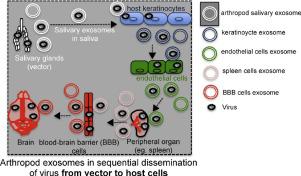Current Opinion in Insect Science ( IF 5.8 ) Pub Date : 2020-06-02 , DOI: 10.1016/j.cois.2020.05.017 Hameeda Sultana 1 , Girish Neelakanta 1

|
Ticks and mosquitoes are medically important vectors that transmit several pathogens, including arboviruses, to humans. Understanding how these blood-feeding arthropods transmit pathogens to humans requires knowledge on the molecular and cellular interplay at vector-host interface. Recent studies have highlighted the role of tick and mosquito small extracellular vesicles (EVs), including exosomes, facilitating arbovirus transmission within arthropod cells and from arthropod to mammalian cells. In this review, we summarize this emerging line of investigation in understanding the role of tick and mosquito exosomes in vector–pathogen–host tripartite interactions. Understanding the role of arthropod exosomes in pathogen interactions could lead to the discovery of novel therapeutic targets to interfere with the life cycle of several pathogens transmitted by vectors.
中文翻译:

节肢动物外来体呈气泡状,带有传播媒介传播疾病的信息。
和蚊子是医学上重要的载体,可将多种病原体(包括虫媒病毒)传播给人类。要了解这些食血节肢动物如何将病原体传播给人类,就需要了解载体-宿主界面上分子和细胞相互作用的知识。最近的研究强调了壁虱和蚊子的小细胞外囊泡(EVs),包括外泌体的作用,促进虫媒病毒在节肢动物细胞内以及从节肢动物到哺乳动物细胞内的传播。在这篇综述中,我们总结了这一新兴的研究方向,以了解壁虱和蚊子外泌体在载体-病原体-宿主三方相互作用中的作用。







































 京公网安备 11010802027423号
京公网安备 11010802027423号